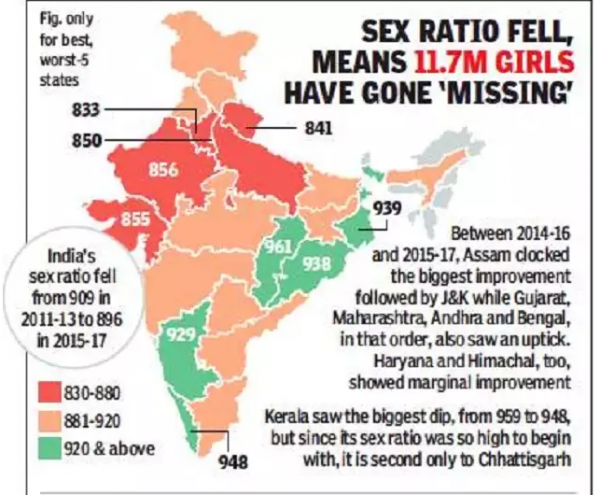“Sex Ratio at Birth” Drops in India – Gender Composition 21/07/2019 – Posted in: Daily News – Tags: fertility rate, girl child sex ratio
SEX RATIO AT BIRTH DROPS IN INDIA
For: Preliminary & Mains
Topics covered: Sex ratio at birth, Highlights of the report
News Flash
India’s sex ratio at birth (SRB) or the number of female babies fell to an all-time low of 896 in 2015-2017.
- From 909 female babies born for 1,000 male babies in 2011-13, states the report by Sample Registration Survey.
- The population ratio was 940 females per 1,000 males, according to the Population Census of 2011.
- Sex Birth Ratio described as the number of female per 1,000 males.
Missing Girls
- During the span of three years, the population growth of female babies was approximately 117 lakh lesser than the male babies.
- Five large states, Uttar Pradesh, Rajasthan, Bihar, Maharashtra, and Gujarat, with poor sex ratios at birth account for about two-thirds of these missing girls.
- Uttar Pradesh- 34.5 lakh girls missing
- Rajasthan- 14 lakh girls missing
- Bihar- 11.6 lakh girl missing
- Maharashtra and Gujarat- 10 lakh girls missing
- Between 2014-16 and 2015-17, Kerala witnessed the biggest dip, from 959 to 948, in sex ratio at birth.
- The states that saw the biggest improvement were Assam and Jammu Kashmir.
Highlights of Survey
- The fertility rate in India has come down from 2.3 in 2013 to 2.2 in 2017.
(The fertility rate is the number of kids likely to be born to a woman.)
- In terms of the Crude Birth Rate (CBR), Bihar with 26.4 is highest whereas Kerala is lowest with 14.2 live births per 1,000.
(CBR is defined as the total number of live births per 1,000 over a time period.)
- The birth rate in both rural and urban area has come down by 1.3 points and 0.6 points, respectively.
- The Crude Death Rate (CDR) in India was at 6.3 in 2017, and it has declined by 0.7 points in the last five years.
- The female death rate at the national level has declined by 0.5 points and the male death rate by 1.0 points.
- Infant Mortality Rate (IMR), children dying within the age of 0-4 years, has come down from 42 in 2012 to 33 in 2017.
- Replacement fertility is the level at which a population can replace itself from one generation to the next without growing or declining and it is estimated at 2.1 children per woman.
- Below this level, the population starts shrinking.
- Nine states have fertility levels higher than 2.1.
- Only in Uttar Pradesh and Bihar are women on average likely to have 3 or more children.
- Of 13 states with below replacement level fertility, Delhi has the lowest.
- India’s total fertility rate has fallen steadily from 3.2 in 1998 to the current level of 1.6 or 1.7.
Source: Dailyhunt
You can follow us on LinkedIn and on Instagram (Diligent IAS) for more updates related to IAS Preparation/ Study Material, Subscribe to our Facebook Page and Youtube Channel- Diligent IAS
Also, read more Daily News Updates
- Income Recognition and Asset Classification Norms
- UN report on “State of Food Security and Nutrition in the World” 2019
- Great Indian Bustard and Lesser Florican
- The Airports Economic Regulatory Authority of India (Amendment) Bill, 2019

